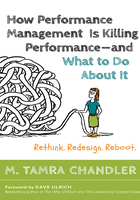
Foreword
PERFORMANCE MANAGEMENT FACES A MAJOR PARADOX. On the one hand, employees and managers all recognize, and studies confirm, that it is the most loathed HR practice. Performance management feels like hazing to the employees being appraised and makes isolated Scrooges of the managers doing the appraisal. As a result, managers hide behind performance management processes meant to quantify and validate behavior. These bureaucratic processes further alienate employees from managers and become administrative folderol. People game the process, and performance management does not improve performance.
On the other hand, accountability matters. Not all employees perform well on all tasks; employees often have differentiated performance; and employees often judge themselves by their intent (which is often positive) more than by their outcomes (which may not be). Without accountability, employees don’t perform as well. Few people wash their rental car before returning it, but many fill it up with gas because of obvious accountability. I have tried to lose weight without weighing in, and my good intentions were not realized without accountability. Without accountability, people are unlikely to change and improve performance.
So performance management faces a conundrum. Don’t do any performance management, and accountability sloughs and performance lags; keep building complicated processes, and the process breaks and performance lags.
Tamra Chandler not only does a marvelous job depicting this performance management enigma, but she also offers some thoughtful alternatives. As a consultant, she has had the opportunity to observe many leading companies that have both succeeded and failed in performance management. Her writing is engaging with clever metaphors, pictures, and examples. She simplified the complex and is inside her reader’s head, trying to rethink and retool performance management.
She starts with what is. Her eight fatal flaws (chapter 2) of traditional performance management will likely leave you nodding in agreement and realizing you are not alone, but also cringing with recognition that good intentions are not working.
She moves to what can be. Her eight shifts (chapter 3) provide a blueprint for moving forward. These shifts are fundamental assumptions about information and people that allow positive accountability to occur.
She then begins with the end in mind by identifying three goals of positive performance management (chapter 4): developing people, rewarding equitably, and driving organization performance. She builds her performance management retooling on this tripod and shows how it can enable a positive conversation.
With shifts and goals defined, she suggests a PM Reboot, where leaders come with assumptions of trust and customization. Trust implies building relationships between employees and managers, listening to each other, sharing decision making, and working together on common goals. Customization means adapting, not adopting, ideas according to the company, job, and individual. Rather than have rigid and standardized processes, work to tailor accountability solutions. She then offers specific performance management redesign solutions in five phases:
• Mobilize: Plan and invite participants to get started.
• Sketch: Align on how to move forward.
• Configure: Prepare a performance solution.
• Build: Adapt the solution.
• Implement: Plan, change, and act on the ideas.
For each of these five phases, she offers specific examples and tools that leaders can use.
What is particularly helpful about Tamra Chandler’s work is that she acknowledges what most have realized: that performance management is less about the process (setting goals, ensuring standards, having consequences, providing feedback) and more about positive conversations built on relationships. But she goes beyond the superficial adage “have a positive conversation” to offer specific guidelines, tools, and words that might allow these productive conversations tooccur. It feels like she is a genie on the shoulder of a manager who wants to help his or her employees improve through a positive and accountable conversation. She is not prescriptive about a process, but she is committed to building trust and customizing an approach to performance improvement. As appropriate, she weaves in research to validate her recommendations (e.g., Hofsted’s workplace cultures). Through the cases she provides, it is obvious that she has had many of these coaching roles and helped well-intentioned managers find the balance between rigid processes and accountability abdication.
Another nice feature about her work is that the principles she proposes apply in both for-profit and not-for-profit settings. I can imagine that these principles could also be adapted to social groups, church settings, and even families, where the paradox of accountability also exists.
Her last chapter (10) is an excellent and valued addition. Many people know what to do but don’t do it (e.g., eating healthy, being kind to strangers, listening more). By anticipating resistances and dealing with them in advance, managers can overcome what might go wrong. Her work parallels the seven disciplines of sustainability that we found in helping leaders sustain the changes they know they should make.
Is this book a panacea for the accountability paradox? Probably not. But it is far more helpful than trudging ahead with what is broken or abandoning all sense of accountability. It is particularly insightful on how to build a customized, trusting relationship through a positive conversation. Will employees like knowing how they are doing and what they need to do to improve? Probably not in many cases. Will leaders like being the bearer of bad news and holding up an accountability mirror? Probably not in many cases. But, by managers rethinking, redesigning, and rebooting performance management, accountability can lead to better-developed people, equitable rewards, and sustained organizational performance.
Dave Ulrich
Rensis Likert Professor of Business, University of Michigan
Partner, the RBL Group